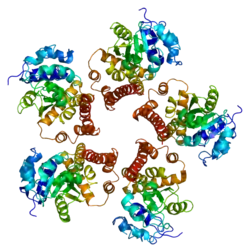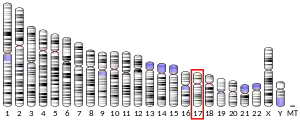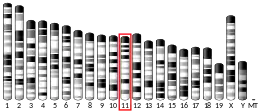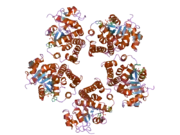PYCR1
Pyrroline-5-carboxylate reductase 1, mitochondrial is an enzyme that in humans is encoded by the PYCR1 gene.[5][6]
This gene encodes an enzyme that catalyzes the NAD(P)H-dependent conversion of pyrroline-5-carboxylate to proline. This enzyme may also play a physiologic role in the generation of NADP(+) in some cell types. The protein forms a homopolymer and localizes to the mitochondrion. Alternate splicing results in two transcript variants encoding different isoforms.[6]
References
- GRCh38: Ensembl release 89: ENSG00000183010 - Ensembl, May 2017
- GRCm38: Ensembl release 89: ENSMUSG00000025140 - Ensembl, May 2017
- "Human PubMed Reference:". National Center for Biotechnology Information, U.S. National Library of Medicine.
- "Mouse PubMed Reference:". National Center for Biotechnology Information, U.S. National Library of Medicine.
- Dougherty KM, Brandriss MC, Valle D (Feb 1992). "Cloning human pyrroline-5-carboxylate reductase cDNA by complementation in Saccharomyces cerevisiae". J Biol Chem. 267 (2): 871–5. PMID 1730675.
- "Entrez Gene: PYCR1 pyrroline-5-carboxylate reductase 1".
Further reading
- Herzfeld A, Legg MA, Greengard O (1978). "Human colon tumors: enzymic and histological characteristics". Cancer. 42 (3): 1280–3. doi:10.1002/1097-0142(197809)42:3<1280::AID-CNCR2820420337>3.0.CO;2-P. PMID 212173.
- Merrill MJ, Yeh GC, Phang JM (1989). "Purified human erythrocyte pyrroline-5-carboxylate reductase. Preferential oxidation of NADPH". J. Biol. Chem. 264 (16): 9352–8. PMID 2722838.
- Yeh GC, Roth EF, Phang JM, et al. (1984). "The effect of pyrroline-5-carboxylic acid on nucleotide metabolism in erythrocytes from normal and glucose-6-phosphate dehydrogenase-deficient subjects". J. Biol. Chem. 259 (9): 5454–8. PMID 6201483.
- Herzfeld A, Greengard O (1981). "Enzyme activities in human fetal and neoplastic tissues". Cancer. 46 (9): 2047–54. doi:10.1002/1097-0142(19801101)46:9<2047::AID-CNCR2820460924>3.0.CO;2-Q. PMID 6253048.
- Yeh GC, Harris SC, Phang JM (1981). "Pyrroline-5-carboxylate reductase in human erythrocytes". J. Clin. Invest. 67 (4): 1042–6. doi:10.1172/JCI110115. PMC 370662. PMID 6894153.
- Maruyama K, Sugano S (1994). "Oligo-capping: a simple method to replace the cap structure of eukaryotic mRNAs with oligoribonucleotides". Gene. 138 (1–2): 171–4. doi:10.1016/0378-1119(94)90802-8. PMID 8125298.
- Basch JJ, Wickham ED, Farrell HM (1997). "Pyrroline-5-carboxylate reductase in lactating bovine mammary glands". J. Dairy Sci. 79 (8): 1361–8. doi:10.3168/jds.S0022-0302(96)76493-7. PMID 8880459.
- Suzuki Y, Yoshitomo-Nakagawa K, Maruyama K, et al. (1997). "Construction and characterization of a full length-enriched and a 5'-end-enriched cDNA library". Gene. 200 (1–2): 149–56. doi:10.1016/S0378-1119(97)00411-3. PMID 9373149.
- Strausberg RL, Feingold EA, Grouse LH, et al. (2003). "Generation and initial analysis of more than 15,000 full-length human and mouse cDNA sequences". Proc. Natl. Acad. Sci. U.S.A. 99 (26): 16899–903. doi:10.1073/pnas.242603899. PMC 139241. PMID 12477932.
- Gerhard DS, Wagner L, Feingold EA, et al. (2004). "The Status, Quality, and Expansion of the NIH Full-Length cDNA Project: The Mammalian Gene Collection (MGC)". Genome Res. 14 (10B): 2121–7. doi:10.1101/gr.2596504. PMC 528928. PMID 15489334.
- Meng Z, Lou Z, Liu Z, et al. (2006). "Crystal structure of human pyrroline-5-carboxylate reductase". J. Mol. Biol. 359 (5): 1364–77. doi:10.1016/j.jmb.2006.04.053. PMID 16730026.
External links
- PDBe-KB provides an overview of all the structure information available in the PDB for Human Pyrroline-5-carboxylate reductase 1, mitochondrial (PYCR1)
This article is issued from Wikipedia. The text is licensed under Creative Commons - Attribution - Sharealike. Additional terms may apply for the media files.










